-
Engine3.5L V6
-
Power268 HP / 248 LB-FT
-
Transmission6-Speed Auto
-
0-60 Time6.7 Seconds
-
DrivetrainFront-Wheel Drive
-
Curb Weight3,497 LBS
-
Seating2+3
-
Cargo16.0 CU-FT
-
MPG21 City / 31 HWY
Toyota has turned over something of a new leaf with its 2013 Avalon. For the last few decades, Japan's largest automaker has shown a face that could best be described as practical, reliable and a bit dull – the same side of the leaf that's been staring consumers in the face with products like the 2013 Camry and Corolla. Popular nameplates, no doubt, but since Toyota's history is filled with such stylish, sporty and iconic models as the 2000GT, MR2, rear-wheel-drive AE86 Corolla and, of course, the late, great Supra that we last saw in 2002, ardent followers of the brand have had little to feel excited about.
With such a checkered past, it's no surprise that company CEO Akio Toyoda has called upon his employees to once again design and build cars with a sense of passion. The 2013 Avalon and Avalon Hybrid – Toyota's flagship models in the ultra-important United States market – are the first new vehicles, Toyota says, to come from that rekindled bucket of excitement. We should note that this notion has raised an eyebrow or three, considering how much excitement surrounds the Toyota GT86 (Scion FR-S in the States).
If nothing else, we can say with certainty that the car's appearance is a dramatic departure from the dour Avalon sedans of days passed. It really is a strikingly attractive car inside and out, but, as has been said time and time again, you can't judge a book by its cover. And so it was with legitimate interest that we fired up the completely redesigned Avalon and Avalon Hybrid for a day-long spin through California's lovely Napa Valley region.
As we mentioned before, the first thing that stands out about the Avalon is that... well, it stands out. Gone are the staid box-it-came-in creases and slab sides of the last generation. In their place are smooth curves and aggressive shapes the likes of which are very welcome in the fullsize sedan market. A good thing, as the Avalon has generally been boring in the looks department since its inception in 1995 as a replacement for the Cressida.
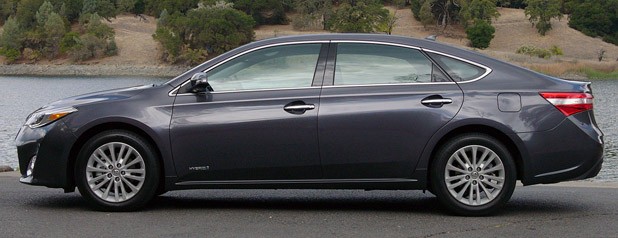
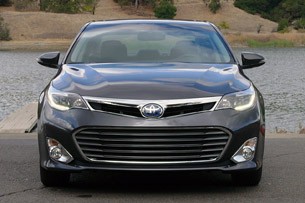
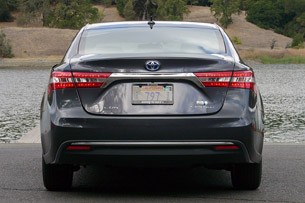
The front of the new Avalon is dominated by a large two-tiered fascia incorporating a sweeping chrome strip with integrated Toyota emblem and a large oval-shaped lower grille. Toyota stylists tell us that the Avalon's face was set in stone before anyone outside Ford had seen the 2013 Fusion, a sedan that is somewhat reminiscent of both the new Avalon and recent Aston Martin models. In any case, we dig its pouty mug and the way it helps the 2013 Avalon stand apart from its competitors.
The bodysides are deeply contoured – so much so, says Toyota, that it had to work with suppliers to ensure the steel stampings could be mass produced – and thoroughly modern. Note the steeply raked C-pillar, a feature that is very much on trend in current automotive design philosophy. Around back things get a bit more traditional. There's a sizable trunk (16.0 cubic feet with the V6 engine or 14.4 cu-ft with the hybrid, due to the location of the battery pack) flanked by two-tiered taillamps and dual exhaust outlets. Three aluminum wheel options are available in 17- and 18-inch sizes, though none of them are particularly sporty looking.Toyota says these are the first non-round projector headlamp units in production.
We do appreciate the lighting up front on Limited models, featuring square-shaped projector lamps with thin LED detailing. Toyota says these are the first such non-round units in production, so we decided to let the car's chief engineer tell us more about these Quadrabeam lights on video.
Toyota is keen to point out that the 2013 Avalon was designed entirely in America at Toyota's design and engineering facilities in California and Michigan, the first such model from the manufacturer to earn that distinction. It's also built in the United States alongside the Camry in Georgetown, Kentucky – all of which makes sense because this model is aimed squarely at the US market and won't be sold in Europe or Japan. In a slight bit of irony, Kevin Hunter, the man in charge of Toyota's CALTY Design Research center, calls the redesigned Avalon "the most American Toyota ever."
Inside, Toyota designers managed to craft a cabin that offers a cockpit feel for the driver, with a wraparound dash design and high-tech attention to detail, while still offering a comfortably clear view of the important controls – climate, infotainment and audio – to the passengers. We very much wish Toyota would offer some modern trim to go along with the fresh cabin's upscale leather besides the obviously fake wood with which every Avalon is fitted. There's a cool, horizontally inscribed matte black plastic facing the driver on many surfaces and, alongside the high-tech gauge cluster's color LCD screen between the speedometer and tachometer and centrally located two-level information screen in the center stack, the plasti-wood stands out like a sore thumb.The man in charge of Toyota's CALTY Design Research calls the redesigned Avalon "the most American Toyota ever."
Toyota's latest Entune technology is included in the 2013 Avalon, bringing with it Bluetooth audio plus a suite of apps including Pandora, Bing, iHeartRadio and MovieTickets.com. Fuel pricing, stock prices, sports, traffic and weather data are also on offer, along with navigation on Touring and Limited models.
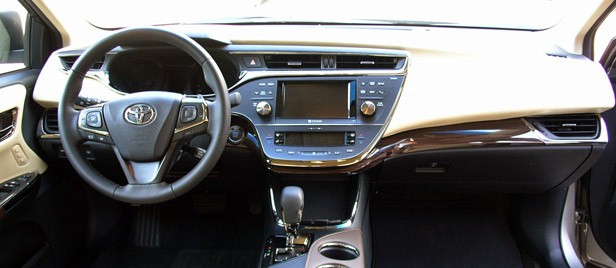
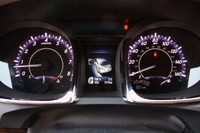
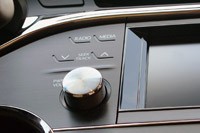
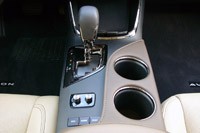
There's an abundance of room inside for five passengers, with over 40 inches of front legroom and 39.2 inches in the rear. Hip (55.1 front and 54.7 rear) and shoulder (58.2 front and 57 inches out back) are similarly generous. Each of these dimensions is a smidge larger than the Camry, with which the Avalon shares a platform, except for headroom. Because of the Avalon's sweeping style and almost fastback-shaped roofline, it's about an inch shorter than the Camry, and that space is claimed from within the cabin. In any case, your author's 6-foot 2-inch frame had no trouble getting nice and comfy in either the front or rear seats, and the attention paid to aerodynamics has resulted in a laudable .28 coefficient of drag.
The 2013 Avalon also brings with it some new technology to the Toyota fold. We mentioned the so-called Quadrabeam headlights, and the Avalon is also the first Toyota product with a Rear Cross Traffic Warning system which warns the driver of oncoming vehicles when reversing. Also new is a stitching process done by hand for the pad over the instruments and steering wheel.Attention paid to aerodynamics has resulted in a laudable .28 coefficient of drag.
Perhaps most interesting, though, are the first-for-Toyota capacitive switches on the center stack. It's no secret that capacative touch buttons have been a polarizing feature on many machines – most notably from Ford and Lincoln, but also in the Chevrolet Volt and Cadillac models equipped with CUE – so Toyota spent lots of time trying to get them right. While we're sure there will still be major detractors (Consumer Reports for one), we found the Avalon's center stack intuitive and very easy to use. Perhaps because of the car's smooth demeanor, and likely due in part to the generous spacing between buttons in the Avalon, we never hit the wrong function while driving and found the layout generally easy to understand.
Toyota is proud of its capacitive buttons, so we gave them an opportunity to demonstrate the technology on video.
According to Toyota, the 2013 Avalon "foreshadows the more compelling and passionate nature of future Toyota products." If that's the case, color us pleased, at least as far as styling goes, because the Avalon – initially sketched by a 20-something designer from Toyota's Ann Arbor-based studio – is so much more expressive than the Camry that it's hard to believe both come from the same manufacturer and are built on the same line.
When it comes to the actual act of driving, we have to call a spade a spade... and this not-so-spade-shaped people mover still drives like the cushy fullsize sedan that it is. Toyota has made huge strides in stiffening the structure of this new Avalon, going so far as to add a bunch of robots to the assembly line for additional spot welds and bracing. Toyota claims to have also placed a specific emphasis on steering response and agility, tuning the Electric Power Steering system for good straight-line stability. The chassis does indeed feel commendably stiff, though the suspension bits holding it up are tuned with comfort in mind.The 2013 Avalon "foreshadows the more compelling and passionate nature of future Toyota products."
There are struts at all four corners that feature rebound springs, which is a nice improvement over the pieces in past Avalon models, but we'd definitely appreciate some sportier calibrations, if not a set of cockpit-adjustable dampers to match the Sport mode (Touring and Limited grades only) that gives the throttle, steering and gear changes better weighting and response. Really, Sport mode just makes the steering feel a bit less overboosted, but we'll take what we can get.
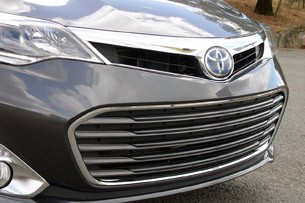
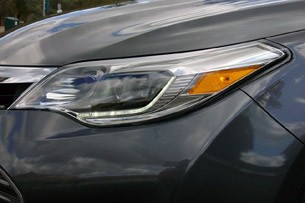
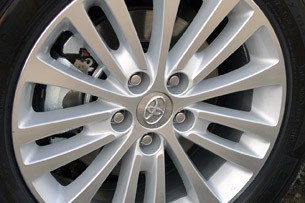
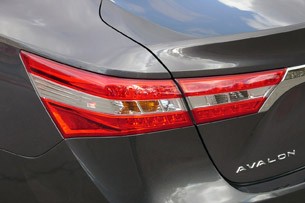
One notable feature included in Sport mode is Dynamic Rev Management. As its name implies, this tech blips the throttle when downshifting and is useful when using the paddle shifters that come on non-hybrid Touring and Limited models. We also like the fact that Toyota included programming to keep the engine at redline for a few seconds before upshifting when using the paddles, which comes in handy when approaching a corner where a shift is undesirable.
There's also an ECO mode that slows the car's responses almost to the point that it seems dangerous – we tested it once and, though we're all for fuel efficiency gains, decided to not touch it again.
If you're looking for a large sedan with the best possible fuel economy, look no further than the 2013 Toyota Avalon Hybrid.
If you're looking for a large sedan with the best possible fuel economy, look no further than the 2013 Toyota Avalon Hybrid. The new model shares engine and transmission componentry with the Camry, but it's recalibrated for use in this new application. Total system output is rated at 200 horsepower; 156 hp and 156 pound-feet from the engine with the rest offered up by the electric motor. While that doesn't sound like a lot for a big car, to its credit, Toyota has been able to keep weight down to 3,458 pounds (base trim), which is within spitting distance of the smaller Camry. Here are the noteworthy details: 40 miles per gallon in the city, 39 on the highway and 40 combined; 680-mile range with a full tank; electric-only mode at speeds less than 25 miles per hour.
In normal driving, we found that the gasoline engine and electric motor deliver adequate acceleration. Toyota estimates a 0-60 time of 8.2 seconds for the 2013 Avalon Hybrid. Because the company has worked out a way to keep cabin heating and air conditioning active even when the gasoline engine is powered off, there's no real penalty in choosing to go the eco route, save for the slight bump in price – provided you don't need a tire-smoking hot rod sedan to impress your neighbors.
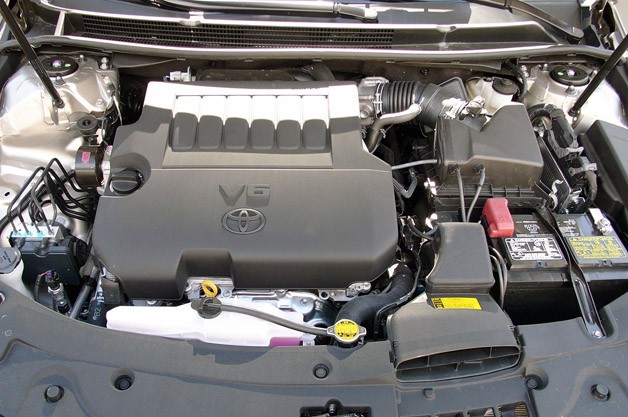
If you really do need a tire-smoking hot rod sedan to impress your neighbors – and really, who are we to judge? – you'll want to opt for the standard 268-horsepower 3.5-liter V6. The engine is a little high strung, making peak horsepower at 6,200 rpm and 248 pound-feet of torque at 4,700 rpm, but it's got plenty of beans to get the Avalon moving in a hurry. Toyota's official 0-60 estimate comes in at 6.7 seconds, and that feels about right. A six-speed automatic gearbox handles shifting duties (that's a few cogs short compared to the eight-speed Hyundai Genesis sedan and Chrysler 300 that are likely to be cross-shopped with the Avalon). Still, the automatic is well suited to this application, with buttery smooth shifts that don't get in the way of driving comfort.
Toyota is hoping to find 70,000 buyers per year for its latest flagship sedan, and it's specifically targeting men and women in the 55-year-old age bracket. That's 10 years younger than the average buyer of the current Avalon, and we applaud Toyota for being realistic about who's shopping in this segment. With a base price of $30,990 – an impressive $2,200 discount over the 2012 Avalon XLE – the Avalon represents a fair value proposition. That said, options such as 18-inch wheels, separate Sport and ECO modes, paddle shifters and an audio system with Entune mean opting for the XLE Touring model for $35,500.With a base price of $30,990 – an impressive $2,200 discount over the 2012 Avalon XLE – the Avalon represents a fair value proposition.
If it were our money, we'd step up to the Avalon Hybrid. It offers a $35,555 starting price in XLE Premium trim ($2,360 over a comparable gas model) but is really best optioned at the Touring level for $37,250 (a more palatable $1,750 increase over its V6 sibling). If you want to go all out with a V6 Limited, it'll cost you $39,650. Want a Limited Hybrid? Be prepared to write out a check for $41,400.
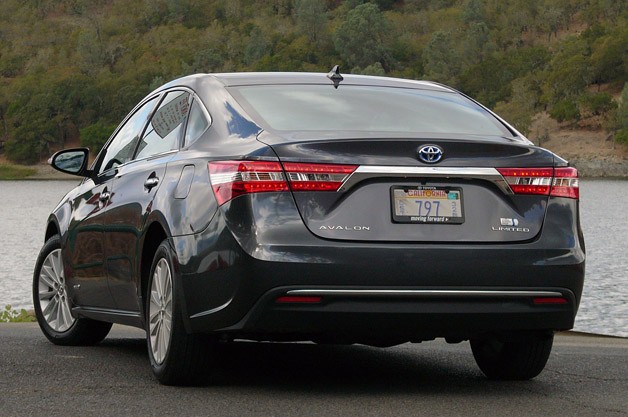 Considering the somewhat well-to-do buyer Toyota is courting and the expressive styling and new technology on offer, the 2013 Avalon is reasonably priced and roughly in line with competitors like the Buick LaCrosse, Chrysler 300 and Hyundai Azera (and, though it's a bit more upscale and rear-wheel-drive, the aforementioned Genesis). The Ford Taurus starts considerably lower, but doesn't really compete at the same level until it's specced with the Limited trim at $33,000. Lincoln is competing for buyers at least one segment up, though the Avalon is certainly a worthy option for buyers to consider.
Considering the somewhat well-to-do buyer Toyota is courting and the expressive styling and new technology on offer, the 2013 Avalon is reasonably priced and roughly in line with competitors like the Buick LaCrosse, Chrysler 300 and Hyundai Azera (and, though it's a bit more upscale and rear-wheel-drive, the aforementioned Genesis). The Ford Taurus starts considerably lower, but doesn't really compete at the same level until it's specced with the Limited trim at $33,000. Lincoln is competing for buyers at least one segment up, though the Avalon is certainly a worthy option for buyers to consider.We could sum up the 2013 Toyota Avalon thusly: The more things change, the more they stay the same.
We could sum up the 2013 Toyota Avalon thusly: The more things change, the more they stay the same. The Avalon has been blessed with a fresh injection of style both inside and out, with new technology that ought to appeal to savvy in-with-the-times buyers, but it still rides and drives largely like a car aimed at ageing middle-class buyers. That's not a bad thing, as far as we're concerned, but we'd love to see what Toyota's engineers could do if they were allowed to let loose a bit with a sportier trim level; something along the lines of the Camry SE, but with legitimate sport sedan tuning. Who knows, they might just get that chance.
As it is, the 2013 Avalon is easy to recommend to the right buyer. If you're in the market for a stylish yet cushy sedan with plenty of room and laudable efficiency, you could do worse than moseying on over to the nearest Toyota dealership to look at the Avalon and Avalon Hybrid. Just don't expect sporting driving dynamics and you won't be disappointed.
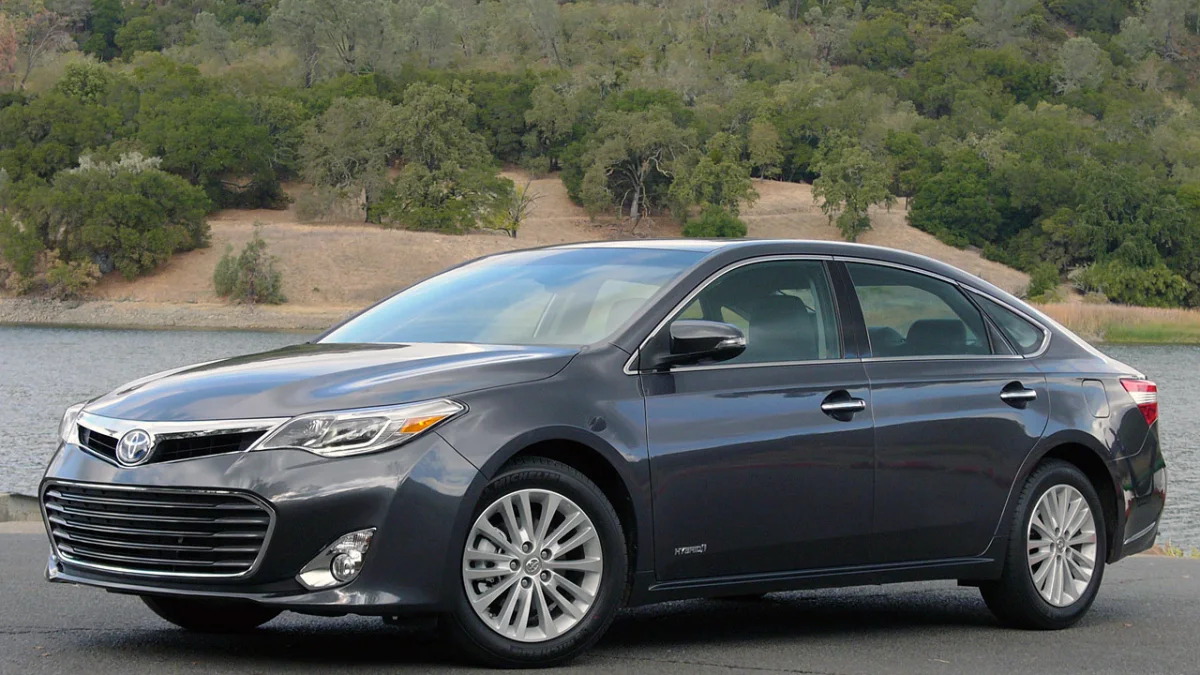









Sign in to post
Please sign in to leave a comment.
Continue